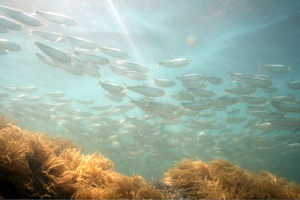 |
| School of mullets |
1st June-9th June, 2006
Low Isles lies eight miles east of the Australian mainland, just north of Cairns. The reef surrounding Low Isles is a typical platform reef. Two different islands have been formed on the reef over time, one a coral cay, Low Island, and the other a mangrove shingle ridge island, Woody Island. Two particular sites were chosen for the study, one in the lagoon on the east side of Low Island, and the other on the back reef on the north side of Low Island. Both of these sites were surveyed on the 1928-29 Great Barrier Reef Expedition.
The study at Low Isles took place over a ten-day period. During this time, water temperature records ranged from 23.6°C to 25.2°C. Mean water temperature was 24.3°C. There were no extreme temperatures recorded.
During our stay at Low Isles, no major bleaching events took place. However, some Goniopora spp. and Montipora spp. colonies were bleached. On the transect and Vitareef dives, only a few colonies displayed signs of bleaching.
During an observational dive on the windward side of the reef, we noticed some bleached Goniopora spp. colonies (<5%). There were a couple of large Goniopora dominated bommies. Most of the submassive colonies appeared mostly healthy except for a few sparse colonies that were completely bleached.
While studying the coral reefs around Low Isles, no diseases were observed among the corals. Low Isles Ranger, Steve Sharpe, also hadn’t seen any diseased corals on the reefs.
While in Low Isles, the visibility was turbid during the entire study. Visibility ranged from 15-30ft (4.5-9.1m). The mean visibility for the two sites was 22.5ft (6.8m). Surprisingly, visibility was better on the lagoon reef (mean vis=20.3ft/6.2m) than on the back reef (mean vis=23.3ft/7.1m). Factors that could be affecting visibility are continental runoff, especially from the Daintree River Delta (approximately 8 nautical miles away), and windy weather mixing bottom silt around this shallow reef.
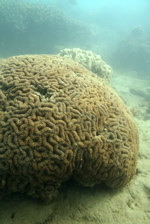 |
| Massive Lobophyllia spp. |
Neither Crown of Thorns starfish nor evidence thereof was observed at the time of our study.
Low Isles consists of two separate islands located on the interior of a platform reef near the mainland of Queensland, Australia. It is eight miles east of Port Douglas and is part of the Great Barrier Reef. Low Isles is the furthest south of the 46 wooded islands, unique to the Great Barrier Reef. Wooded islands are formed when broken corals wash up on the reef flat above the high tide mark. Larger coral pieces concentrate on the windward, southeastern, side of the reef where they form a barrier to the constant wave action. Mangroves tend to settle behind these walls creating a mangrove island. On the leeward side of the reef, finer sediments accumulate creating a coral cay. A coral cay is located on the northwest side of the reef, known as Low Island. The other larger island is a mangrove island on the southeast edge of the reef that is continually expanding, named Woody Island.
Low Isles has a rich history including Aboriginal significance and scientific importance. Stories claim that mainland Aborigine communities used Low Isles as a peace island. The heads of opposing clans would paddle out to Low Isles to settle disputes. Lieutenant James Cook spotted and named Low Isles in 1770 just days before wrecking on Endeavor Reef. In November 1878, people first settled Low Island when the lighthouse was built. A lighthouse keeper and his family lived on the island and maintained the lighthouse. In 1911, a cyclone struck the island, denuding it of its vegetation.
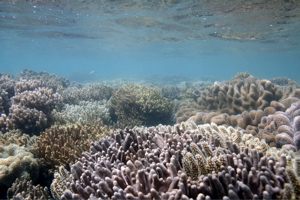 |
The 1928-29 Great Barrier Reef Research Expedition, primarily funded by the Royal Geographical Society, was based on Low Isles. Sir Charles Maurice Yonge led the expedition, which was the first comprehensive ecological study of coral reefs. Experiments and surveys of the reef led to further insight about the creation of coral reefs and the life histories of the corals and associated fauna. Numerous studies have since been carried out on Low Isles.
Today, Low Isles is part of the Great Barrier Reef Marine Park (GBRMP) and the Great Barrier Reef Heritage Area. In addition, Low Isles is also protected as a sensitive area by the Cairns Area Plan of Management. Under the GBRMP zonation plan July 2004, Low Isles is designated a green zone. Greens zones are strictly no-take zones. Activities such as fishing or collecting are not permitted, however diving, snorkeling, swimming, boating, and sailing are allowed. Commercially, 300 tourists per day are licensed to visit Low Isles by boat. However, an average of approximately 150 people per day visit this area, many of whom are swimming, snorkeling or diving this reef.
The marine life isn’t the only interesting thing around Low Isles. Woody Island hosts nesting and roosting sites for birds. In the summer months, November to March, 25,000 pairs of migrating pied imperial-pidgeons stop to nest on Woody Isles.
Corals fringe the entire reef system. Coral growth exists in shallow water and gradually extends to a depth of 25-30 feet where sandy bottom with coral patches dominates. The southeast side of the reef is the windward side where the reef crest bears the impact of large southeasterly wind and waves. Coral rock and large Goniopora and Porites spp. boulders make up most of this wave-battered fore reef. The back reef is on the northwest to north side of the reef, protected from the strong trade winds. This side of the reef has many coral bommies and Porites spp. boulder patches rising from sandy bottom. In the lagoon, there are a few large bommies that fringe the northeast side of Low Island. These drop off to a sandy bottom. The anchorage and mooring area, in the center of the lagoon has sand bottom with the occasional coral patches. Much of the reef crest between Low Island and Woody Island is coral rock covered with algae and some soft corals.
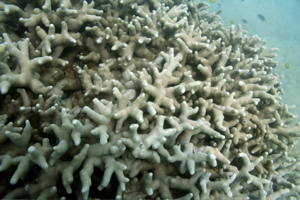 |
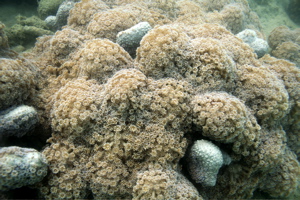 |
| Patch of Porites "fingers" | Large colony of Goniopora sp. |
The Low Isles reef posses a high diversity of coral genera and a high coral coverage at both of the study sites. Large fields of soft coral are interwoven between scleractinian coral colonies. A considerable amount of juvenile coral colonies were observed indicating the presence of many new recruits on the reef.
The Porites genus was dominant throughout the reef. Large Porites boulders and significant patches of Porites fingers were present in great numbers, both in the lagoon and on the back reef. On the back reef, the Acropora genus was also dominant. Although several large staghorn Acropora colonies were seen on the sand bottom, the table Acropora appeared relatively small. During the GPS tracking, extensive fields of encrusting and massive Goniopora spp. were seen around the wave exposed sections of the Low Isles reef
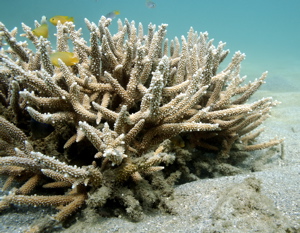 |
| Colony of branching Acropora sp. |
The coral colonies observed appeared to be mostly healthy. Sediment accumulation seems to be the major threat to live corals. Many corals showed signs of sediment accumulation, and there were signs of recent tissue necrosis due to sediment damage. The Vitareef study demonstrated that just over 20% of all hard coral colonies observed showed either signs of excessive sediment on tissue or tissue necrosis due to excessive sediment accumulation.
Structural damage to corals is a concern to many reefs that are frequently visited by tourists. There was very little evidence of physical structural damage to any coral colonies comprising this reef. This demonstrates the efficiency with which tourism is managed, providing minimal impact on this ecosystem.
Due to Low Isles’ status as a Marine Park, no fishing of any sort is allowed within the region. Mostly small to medium-sized, herbivorous fish were observed on the transects, however a few commercial species were seen, which included fish in the grouper, snapper, barramundi, and emperor families, all of various sizes. Some mid-sized groupers and coral trout were observed close to the transect area. Many ornamental aquarium fish were also observed on the transects including the Harlequin Tuskfish, angelfish, butterflyfish and batfish. The fish diversity was relatively high reflecting the diverse environments in the area: mangrove swamp, seagrass beds, and coral reef. A total of four thousand one hundred eleven fish within ninety-two different fish species were observed over the course of four transects.
Many remoras were seen swimming through the region. During the evening hours, juvenile black-tip reef sharks and giant trevally chased large schools of mullet along the beach of Low Island. Some unidentified sharks were observed circling shrimping boats as they arrived in the anchorage in the early morning hours. A minute leatherjacket (Rudarius minutus) was seen perched in a soft coral on a Vitareef dive on the back reef of Low Isles. Also, a beautiful Red Emperor Snapper (Lutjanus sebae) roamed around the lagoon reef and was observed on the fourth transect dive and a Vitareef dive.
 |
| An emperor fish |
Fish behavior was very peculiar. Many of the reef fish in the region, including many typical table fish, seemed unafraid of both divers and snorkelers. Many tour operators made frequent trips to these reefs during our stay, which, over time, might have altered the behavior of these fish.
The reefs of Low Isles have a high soft coral coverage. The dominant soft corals include Mushroom Leather Coral (Sacrophyton spp.), Lobed Leather Coral (Lobophyton spp.), and Digitate Leather Coral (Sinularia spp.). Many bommies in the lagoon were covered in blue coral (Heliopora coerulea). It appears blue coral could be a major reef builder on the lagoonal reef. Organ pipe coral (Tubipora musica) was also abundant on this reef, particularly in the silty areas between scleractinian corals.
Various species of Giant Clams were littered around the reef. The dominant species was the Crocus Giant Clam (Tridacna crocea), all of which were between 2-14 cm long and burrowed in Porites spp corals. A few Large Giant Clams (Tridacna maxima) of 15-30 cm length were found on the reef. A one meter long Giant Giant Clam (Tridacna gigas) was seen on the back reef during the second transect. Numerous China Clams (Hippopus hippopus) were observed in shallow sand flats and in seagrass beds in and around Woody Island. Many of these China Clams were completely exposed to air during the low tides. The abundance of giant clams of the various species is an indicator of a healthy and diverse ecosystem.
Only one sea cucumber was observed on the four transects. No live trochus were observed, although an empty trochus shell was found. No Crown of Thorns (COTs) starfish, or evidence thereof, were observed on this reef.
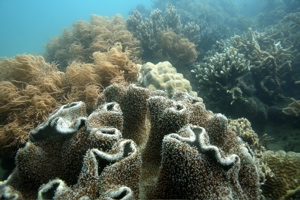 |
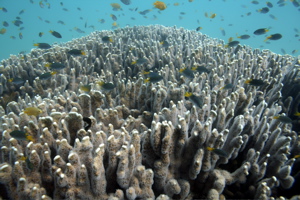 |
| Soft corals | Blue coral Heliopora coerulea |
As usual, Christmas tree worms and bio-eroding mussels were found in many Porites spp. corals. Many brittle stars were seen within the Porites spp. corals, as well. Two nudibranchs were found grazing on dead coral rock, one of which was identified as Phyllidia vericosa. Five barrel sponges and a few other encrusting sponges were observed on the transects. An unusually large lobster (Panulirus sp.) and an octopus (Octopus sp.) were observed under a Goniopora spp. bommie midday on the windward side of the reef during an observational dive.
Over the course of our stay at Low Isles, two dolphin sightings occurred. Upon our arrival to Low Isles, around 0600, one or two bottlenose dolphins were observed swimming slowly about a half mile from the ship. On departure, a pod of about 4 bottlenose dolphins were sighted about 5 miles away from Low Isles. Both encounters were brief, and neither pod approached the ship.
The ranger of Low Isles reported that he has observed dolphins following the shrimp boats, which anchor around Low Isles during the day and fish offshore in designated areas at night.
Sightings of turtles surfacing over the reef were frequent around Low Isles. The turtles hold a strong presence on this reef, and several were seen on almost every dive. The turtles rarely appeared bothered by the divers, as some of us were able to observe and photograph them for several minutes. The majority of the turtles sighted were Green Turtles (Chelonia mydas) between 40-80 cm carapace length. Hawksbill Turtle (Eretmochelys imbricata) sightings were less common. The hawksbills were between 30-45 cm carapace length.
The Low Isles park ranger, Steve Sharpe, reports that the turtles on this reef are mostly juveniles, and will continue their migration to bigger reefs after they begin to mate. This reef and adjacent seagrass beds seem to be a feeding site for juvenile green and hawksbill turtles. The origin of these turtles is unknown. There are tagged turtles on this reef, which may be part of a study on sea turtle migrations. Steve also reported that Low Island was formerly a nesting beach, and the last known nesting year was 1965. Because sea turtles return to their natal beach to mate and lay their eggs, it is assumed that this nesting population has become extinct.
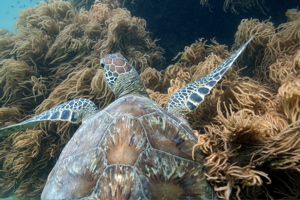 |
| Green Turtle |
Presently all sea turtle species are recognized as endangered. In Australia it is illegal to harvest or even contact sea turtles and their nests. However, Aboriginal and Torres Strait Islander communities can legally collect sea turtles and their products “for the purpose of satisfying personal, domestic, or communal needs” as defined in The Great Barrier Reef Marine Park Zoning Plan. It does not appear that any harvesting takes place on Low Isles. Mainly eco-tourist dive and snorkel groups visit this reef.
The preservation of Low Isles reef is promising for this population of juvenile sea turtles that depend on this habitat to feed and grow until they are ready to migrate back to their natal beach to mate. Further studies on the origin and future destinations of these sea turtles would be useful for the holistic effort to protect all habitats of these endangered species of our oceans.
Although the reef appears to be in fairly healthy condition, a couple of factors may be threatening the reef of Low Isles. As we noticed during our science dives, many corals appeared to be choked from sedimentation. All around the reef, many corals were covered in a thin film of silt. About a quarter of the corals surveyed in the Vitareef study either had excessive sediment or sediment causing tissue necrosis (26.19% combined on the back reef and 21.43% combined on the lagoon reef).
The expanding mangrove forest on Woody Island, which has expanded almost twice its size since the 1928-29 Expedition, could be contributing to the sedimentation problem on the reef. However, as forests continue to be harvested or cut down for new settlements and agricultural lands, erosion of the topsoil gets worse, especially during heavy rains, such as the precipitation from the monsoon and cyclones. Eroded sediment around the Port Douglas area of Australia fills up the Daintree River and eventually travels out to the reefs, particularly the nearshore reefs like Low Isles.
The other major threat to the reef is cyclones. Cyclones typically form in this region of the world from January to April. Cyclones that directly hit this area can cause major physical damage to the reefs. As wind from cyclones build up the sea, waves crash into the reef at such a force that many corals break or roll over. In addition to the physical destruction of the reef, cyclones bring heavy rains that flood the mainland. The water exiting the Daintree River form fresh water plumes that stand stagnant in areas. According to Low Isles Ranger, Steve Sharpe, a couple of fresh water plumes from severe monsoonal rains and cyclones have sat over Low Isles, killing off most corals on the reef crest.